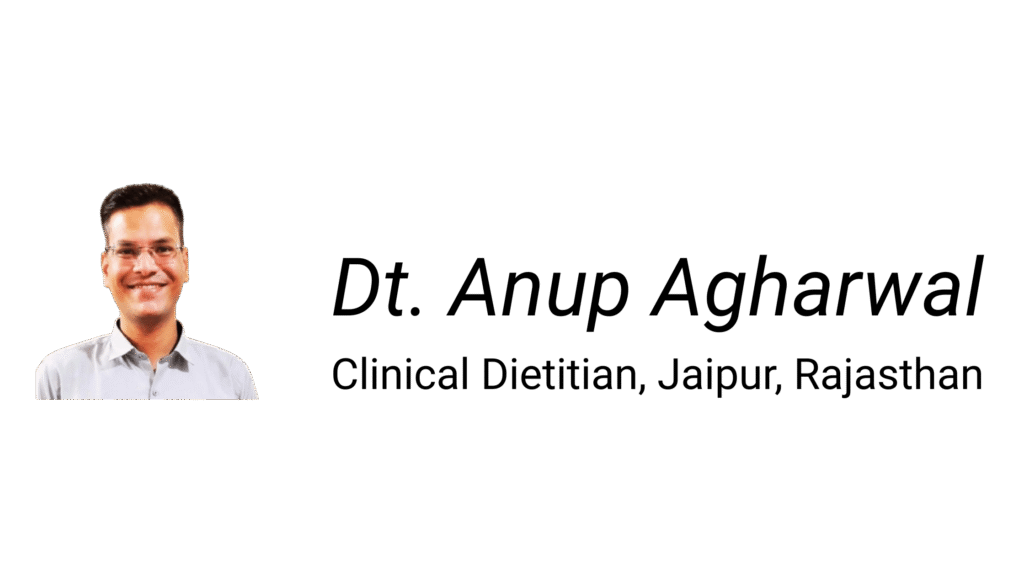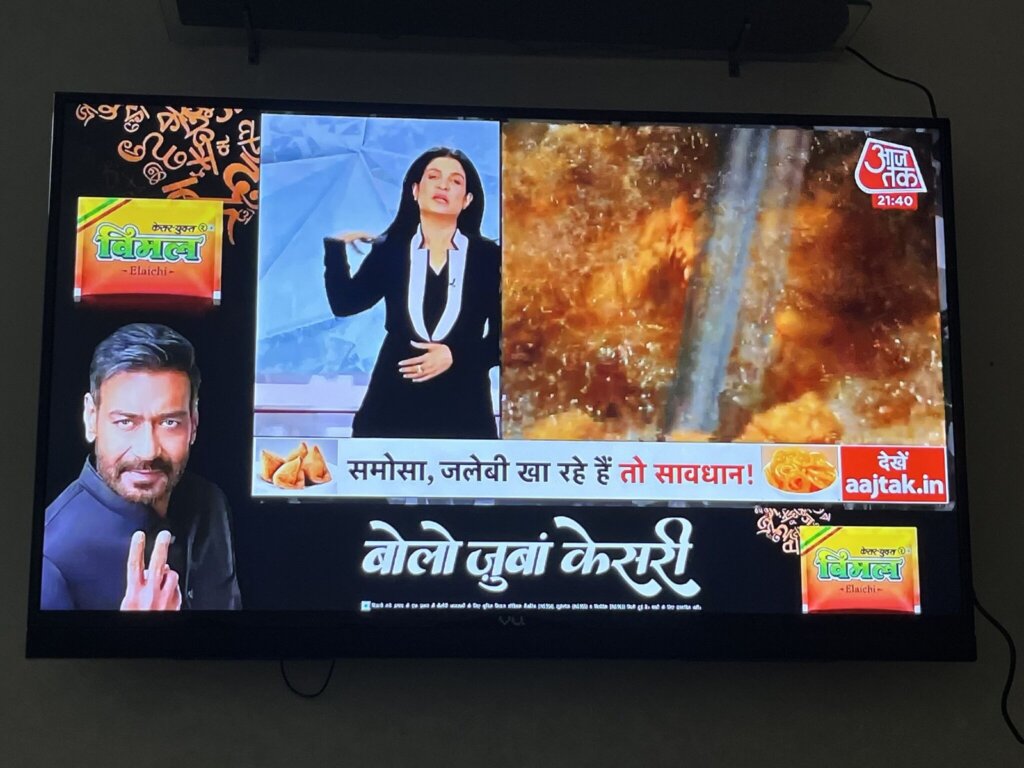
Disclaimer:
This blog is a neutral commentary—not intended to defame any individual, brand, or media organization. It highlights a curious media contradiction and promotes awareness for better advertising responsibility and health messaging.
Table of Contents

I still remember the evening I switched on the TV to watch a health awareness program. The anchor was talking seriously about how oily and processed food increases the risk of heart disease. I was listening carefully until my eyes went to the bottom of the screen.
There it was, a Vimal Pan Masala advertisement, playing cheerfully with the line “Bolo Zubaan Kesari.”
It made me pause for a moment. The same screen was giving me health advice on top and showing a pan masala ad below. Isn’t that strange?
This small moment made me think deeply about what’s happening in Indian media today. Are we truly fostering health awareness, or might we be unintentionally mixing positive messages with confusing advertisements?
In this blog, I want to talk openly about this contradiction, how Vimal pan masala ads and similar promotions are creating confusion, what this situation says about our media ethics and what we can do about it.
The Story Behind Vimal Pan Masala Ads
I’ve noticed that Vimal Pan Masala advertisements are everywhere on TV, YouTube and even during family shows. Big celebrities like Shah Rukh Khan, Ajay Devgn and Tiger Shroff appear in them, smiling confidently and saying that every grain has saffron.
Recently, people in Jaipur sent a legal notice to these actors and the company, questioning the authenticity of the “saffron” claim. Real saffron costs thousands per kilogram so how can it be in a five-rupee sachet?
To me, this incident shows a clear problem in how companies market such products. They often promote Vimal Elaichi, which seems harmless but in reality, it keeps the Vimal pan masala brand alive in people’s minds. This trick is called surrogate advertising selling one product while secretly promoting another.
Why This Is a Matter of Media Ethics

Now, I’m not against advertising. I understand that media channels depend on ads for revenue. However, could we consider the media ethics involved when a health program is placed alongside a pan masala advertisement?
This issue isn’t just about one brand. It’s about how news channels, digital platforms and even influencers prioritize money over message. When I see a news anchor warning people about oral cancer and below that an ad for mouth freshener or Vimal pan masala, it feels like we’ve lost the sense of responsibility.
Recommended Video:
It’s not just TV. On social media, the problem is even bigger. Many influencers post health tips in one video and promote unhealthy products in the next. That’s where social media ethics come in. People follow these creators for guidance but when health and marketing mix up like this, viewers don’t know whom to trust.
How It Affects Public Health Awareness
I believe this constant contradiction confuses people. Imagine a viewer who’s trying to quit tobacco or pan masala. He watches TV to learn more about health and then sees his favorite actor smiling in a Vimal Pan Masala advertisement. What message is he truly receiving?
Over time, such mixed messages reduce our health awareness. We become used to seeing health advice and harmful promotions together, so we stop noticing the difference. The message loses its power.
And that’s dangerous because products like pan masala, even when they claim to be “tobacco-free,” can still harm our mouth, teeth and digestion. They’re often full of artificial flavoring, coloring agents and chemical additives.
Many such snacks are heavily marketed just like pan masala; see the 5 most unhealthy Indian snacks here.
What We Can Do About It
I’m not writing this piece to blame one brand or one channel. My goal is to make people like you and me more aware.
Media Channels
News and entertainment platforms should clearly distinguish between editorial content and advertising. Health-related programs should never run side by side with pan masala ads. That’s a basic step toward restoring trust.
News and entertainment platforms should clearly distinguish between editorial content and advertising. Health-related programs should never run side by side with pan masala ads. That’s a basic step toward restoring trust.
Advertisers
Brands like Vimal Pan Masala need to be more transparent. Don’t use “elaichi” or “mouth freshener” as a cover. Don’t make false claims like “every grain has saffron.” It’s misleading and unethical.
Regulators
There should be stronger laws to stop surrogate advertising. These legal loopholes allow companies to bypass bans and influence young audiences.
Viewers Like Us
In today’s fast-paced world, where ads reach us through every screen, media ethics are not just about rules they’re about respect for the viewer’s mind.
When I turn on the TV, I expect honesty. I don’t want to be told to “live healthy” in one breath and “chew pan masala” in the next. That’s not just confusing; it’s hypocritical.
The same goes for social media ethics. Influencers and creators have a big role to play. If you promote wellness, stay true to that message. Don’t mix it with products that can harm people in the long run.
A Call for Health Integrity
The issue of media ethics and advertising in India is not just a legal or business problem; it’s a moral one. When I see health ads vs. pan masala ads on the same screen, it feels like truth and temptation are fighting for attention.
We, as a society, have to decide which one wins.
For me, it’s simple: truth must win. Awareness must win. Health must win.
The Vimal Pan Masala advertisement and other such pan masala ads should remind us that shiny commercials can hide serious contradictions. It’s our job as viewers, creators and citizens to question them.
Let’s create a future where health awareness messages stand alone, not side by side with the very things that destroy it.
Frequently Asked Questions (FAQ)
1. Can pan masala cause cancer?
Ans. Yes, regular use of pan masala can lead to oral cancer, especially due to ingredients like areca nut (supari) and chemical flavoring. Even “tobacco-free” versions are not safe. Over time, they can damage the mouth, gums, and throat lining. This is why I keep saying health awareness is the real need of the hour.
2. What is surrogate advertising?
Ans. Surrogate advertising means promoting a banned or harmful product through another “safe” product.
For example, when a company advertises Vimal Elaichi instead of Vimal Pan Masala, it’s a hidden promotion. It confuses viewers and keeps the main brand alive without directly breaking the law.
3. What are some examples of surrogate ads on Indian TV?
Ans. A clear example of surrogate ads on Indian TV is when alcohol or pan masala brands promote unrelated products like music CDs, soda or elaichi. These ads might look innocent but they remind people of the original brand and that’s how the marketing works.
4. How does surrogate advertising confuse viewers?
Ans. It confuses viewers by mixing signals. When I see an elaichi ad with the same logo and celebrity from a pan masala advertisement, I subconsciously connect it to the main brand. That’s how surrogate advertising confuses viewers; it makes harmful products seem acceptable through emotional storytelling and celebrity faces.
5. What is the impact of surrogate ads on public health?
Ans. The impact of surrogate ads on public health is serious. These ads normalize unhealthy habits and weaken public trust in health campaigns. People start believing that if something is shown on TV with a celebrity, it can’t be that bad and that’s a dangerous belief.
6. Why are Vimal Pan Masala advertisements so controversial?
Ans. This is due to their tendency to blur the distinction between a “mouth freshener” and a pan masala advertisement. Their marketing often uses cultural values, luxury imagery, and Bollywood stars to create a positive image even though the core product has major health risks. It’s a perfect example of marketing power without ethical limits.
7. What do media ethics have to do with such ads?
Ans. Media ethics mean doing what’s right for the audience, not just what earns money. When news channels show health awareness messages and pan masala ads together, they fail this responsibility. It sends a mixed message that hurts credibility and public trust.
8. How are social media ethics connected to this issue?
Ans. On social media, influencers often promote wellness in one post and harmful products in the next. That’s where social media ethics come in. As a creator or health coach, I feel it’s my duty to stay consistent; no one should promote both health and harm on the same platform.
9. Why do health ads and pan masala ads appear together on Indian TV?
Ans. It happens because ad placement is automated and profit-driven. Channels often sell slots to whoever pays more, even if that means a Vimal pan masala advertisement plays right below a health story. This strange clash of health ads vs. pan masala ads in India exposes how much we need better advertising control.
10. What can viewers like me do to promote ethical media?
Ans. We have more power than we think. If you come across a misleading or contradictory advertisement, please consider taking a screenshot and addressing it on social media. Tag the brand or channel and ask, “Is this advertisement ethical?” Public voice matters. When more people question, media and brands are forced to act responsibly. That’s how real health awareness begins.

🎯 10+ years of Experience
🎓 10k+ Trained ( 📍 Jaipur )
💪 Helping change people’s lives
🌿 Most trusted lifestyle counselor